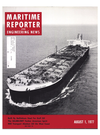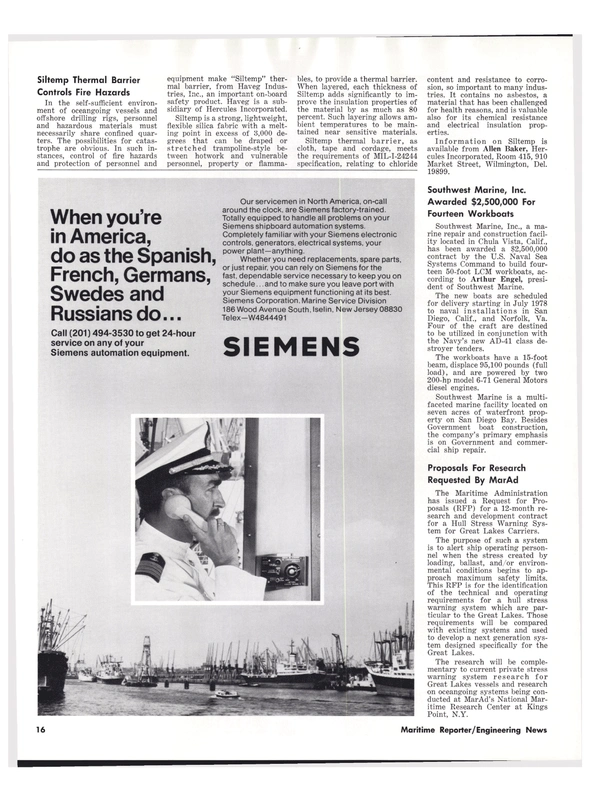
Hydra lift Skegs
Developed By Seaspan Development Co. Ltd.
Of British Columbia, The New Skeg Design Results In A 10 To 15-Percent Higher Speed Or 20 To 30-Percent Reduction In Power Required To Tow Loaded Barges At The Same Speed A Canadian invention which reduces the power needed to tow loaded barges by up to 30 percent was used to speed the delivery of the drill rig Interocean II from Japan to the U.S. Gulf recently.
An average speed of 10 knots was achieved under the most adverse towing conditions on a semisubmersible barge which is 400 feet in length and has a 100-foot beam.
The barge is owned by Genstar Overseas Limited of Hamilton, Bermuda, and operated by Global Transport Organisation.
Hydralift Skegs, developed by Seaspan Development Co. Ltd. of Vancouver, British Columbia, are a dramatic breakthrough in skeg design, resulting in 10 to 15-percent higher speeds or 20 to 30- percent reduction in the power required to tow at the same speed.
Conventional skegs create a significant drag as they provide the necessary stability. This increases the power required to tow them.
This new skeg design applies the principles of aerodynamics to the design of skegs. A lift is induced by the airfoil shape of the skegs to establish stability while at the same time producing a forward component of lift, thereby reducing drag.
The theory was exhaustively tested over a two-year period by its inventor Josip Gruzling, and Jacques Heyrman, the vice president of the development subsidiary of Genstar Marine Limited.
This resulted in a 400-foot by 100- foot barge sliding down the ways in Japan in 1976, equipped with the Hydralift Skegs. The barge, which is owned by Genstar Overseas Limited, was followed by five sister barges.
Mr. Heyrman, speaking in retrospect, described the invention of the Hydralift Skeg as an amazingly simple and obvious concept.
"It was simply a matter of transferring known principles from an air medium to a water medium," he said.. . . "No moving parts, yet this skeg system saves fuel and conserves energy—to say the least, it is a timely invention." Hydralift Skegs are a radical departure from conventional skegs in current use. Conventional skegs increase total barge resistance by 25 percent to 50 percent.
Hydralift Skegs not only provide the required directional stability of the towed vessel, but maintain a total barge resistance close to or even in some cases slightly less than the bare hull resistance of the vessel.
Hydralift Skegs consist of a number of vertical, high aspect ratio foils fitted to the barge and positioned at each side of the stern barge rake, and horizontal foils connecting the bottom tips of each set of vertical foils.
The key to the remarkable efficiency of the Hydralift Skegs is the optimization of skeg profile and angle of attack to the flow of water. The invention enables this to be applied specifically to each barge design. The barge is stabilized by lateral lift induced by the foils which counters the drift of the barge stern, and which at the same time generates a forward component of lift which not only cancels out the frictional drag of the skegs but cancels out some of the barge hull resistance as well.
Hydralift Skegs are of benefit to barges over 5,000 tons deadweight, contemporary barges with shallow rake angles compatible with Hydralift Skegs, and particularly to barges used on long distance hauls where the transit portion is a high percentage of the total transport cycle.
Hydralift Skegs enable a reduction in horsepower of 20 percent to 30 percent at constant speed. Another way to translate this is an increase in speed of 10 percent to 15 percent at constant horsepower. The savings in fuel and the increases in operational efficiency are obvious.
Seaspan Development Co. Ltd.
(SeaDevCo), based in Vancouver, British Columbia, Canada, is an arm of Genstar Marine Limited established to research and develop technological advances in marine transportation in association with Seaspan International Ltd., Canada's foremost tug and barge company. Genstar Marine, through its operating companies and affiliated organizations, is also involved in marine transportation in the Canadian Arctic and in eastern Canadian waters.
The development of Hydralift Skegs was achieved by this group and Hydralift's exclusive design consultant, Nautican Research & Development Ltd. SeaDevCo makes the device available in three ways: 1. The use of the invention under license arrangement to shipyards, builders, naval architects and owners. SeaDevCo prefers to be involved not only in the design but in the construction stages of the new equipment as well.
2. Design of the skegs by Sea- DevCo and fabrication by Vancouver Shipyards Co. Ltd., a sister company located adjacent to Sea- DevCo. The skegs would then be made available to owners for installation under SeaDevCo supervision.
3. For vessels which trade in the Pacific Coast Region, design of the Hydralift Skegs by Sea- DevCo and fabrication and installation of the skegs by Vancouver Shipyards. This would involve the installation of the new replacement skegs on barges already in operation, as well as new barge construction.
For further information and technical data relating to Hydralift Skegs and how your barge fleet may benefit from the breakthrough in skeg design, contact Jacques Heyrman, Seaspan Development Co. Ltd., 10 Pemberton Avenue, North Vancouver, B.C., Canada V7P 2R1.
Read Hydra lift Skegs in Pdf, Flash or Html5 edition of August 1977 Maritime Reporter
Other stories from August 1977 issue
Content
- U Of Michigan Adds Naval Architecture- Engineering Facilities page: 4
- Falcon Cargo Ships, Inc. Plan To Construct Five Dry-Bulk Cargo Ships page: 6
- Clarence French Named President Of NASSCO page: 6
- Waterman Plans To Build Either An $80-Million Or An $87-Million Vessel page: 7
- Micro Line Systems Apply For Title XI For Ro/Ro Containerships page: 7
- Santa Fe Completes Phase One Of Arabian $161-Million Project page: 8
- $81 -Million Tanker American Spirit To Transport Oil From Alaskan Pipeline To Panama Canal page: 10
- Newest Addition To ACBL Towboat Fleet Named For Texas Gas Transmission President page: 10
- Paul-Munroe Acquires Rucker Marine Systems page: 10
- Flume Stabilization Names Peter Maschke page: 10
- Liaison With Maritime Industry Subject Of Stevens Tech Meeting page: 12
- 11,000-Ton Drilling Rig Towed 15,000 Miles page: 13
- Dytam Establishes New York Office page: 14
- Hydra lift Skegs page: 14
- Siltemp Thermal Barrier Controls Fire Hazards page: 16
- Northwest Marine Receives Major Navy Contract page: 16
- Genstar To Purchase Gulf Of Georgia Towing page: 16
- James Dunford Named CDI Vice President page: 17
- Ryan-Walsh Names Robert Matthews VP page: 18
- Prudential Lines Names Karl Eckhardt VP And General Manager page: 18
- IACS Group Agrees To Develop Additional Safety Standards page: 19
- Icebreaker Barge With Twin Notches In Stern Leads Arctic Sealift page: 20
- Inert Gas Systems Fitted Aboard Tankers Building At NASSCO page: 20
- Rohr Industries Names Filiciotto And Walsh page: 20
- Hyundai Mipo Dockyard Converting Two Bulkers Into Ro/Ro Ships page: 21
- Biehl & Company Announces Managerial Promotions In Houston page: 21
- Eleusis Shipyards Elect New Board Of Directors page: 22
- National Supply Names World Marketing Group For Drilling Equipment page: 22
- Airfilco Engineering Names John E. Riley VP And Gen'l Manager page: 22
- Three-Day Weather Conference And Exhibit page: 22
- GT&T Announces Management Changes page: 23
- Pott Industries Inc. Becomes HNG Subsidiary page: 24
- American-Arab Chamber To Open New Orleans Office page: 25
- Steamco II, Inc. Opens Office In Jacksonville —Whitney Appointed page: 25
- Halter Marine Launches 180-Foot Vessel For Martin page: 26
- Underwater Acoustic Explorations At The University Of Rhode Island page: 29
- N.C.S. Of Cairo, Egypt Appoints Pouch Terminal page: 29
- A Salute To The American Merchant Marine Leadership In World Maritime Safety page: 30
- Henry Olson Joins Morris Guralnick Staff page: 30
- McMullen Assoc. Opens Hampton Roads Office —Joseph Bunting Named page: 30
- Charles Hurd Joins Southwest Marine, Inc. page: 30
- Howard Named Marketing Manager For G.E. Credit Leasing Component page: 31
- Marine/Offshore Rules And Regulations Topics Of Seminar page: 31
- Seaworthy Appoints Patrick J. McAllister page: 31
- Prudential Agrees To Sell South American Shipping Operations page: 31
- Seaworthy Appoints William L. McCarthy page: 32
- Deep Penetration Gas Freeing Fan Introduced By Dasic page: 32
- Ocean Engineering Under Arctic Conditions Is Subject Of Conference page: 34
- Lake Shore, Inc. Opens Houston, Texas Office— G. Curtis Gibby Named page: 34
- ABS Forms 18-Member Hong Kong Technical Committee page: 36
- Evergreen Handt Names Two In Operations page: 37
- Int'l Chamber Publishes Bridge Procedures Guide page: 37
- Twin City Barge Entering Coal Business page: 38
- Great Lakes Steamship Division Of Bethlehem Appoints Roy Dobson page: 38
- Edo Western Corp. New Deep Tow Survey System page: 38
- Crowley Maritime Corp. Orders Two 580-Foot Triple-Deck Barges page: 39
- Central Gulf Promotes Smith And Ferguson page: 39
- Modern Collision Avoidance System Subject Of Symposium page: 40
- Stewart & Stevenson Deliver Three Crewboats To Italy page: 41
- Setenave Shipyard Acquires Rights To Use Kockums System page: 43
- James Moseley Heads Port Of Jacksonville Propeller Club page: 44
- Carter Group Sees Zapata Rig At Work page: 45
- First International Symposium On Computer Aided Hull-Surface Definition page: 46
- Diving And Insurance Symposium Scheduled Nov. 14-15 In New York page: 46
- Equitable Shipyards, Inc. Ships Last Two In Series Of Five 95-Foot Tugs To Indonesia page: 49
- Electro-Nav's Fifth Annual Navigation And Communications Exhibit Held In New York page: 49
- Butterworth Systems Relocates Headquarters page: 50
- New Engine Room Simulator To Improve Supertanker Training page: 52
- Ohio River Company Towboat M / V Queen City Receives Nation's Highest Safety Award page: 53
- E.R. Remkes Named President Of C-E Crest, Tulsa Engineering Firm page: 53
- Proceedings Of First N.Y. Port Com-Nav Conference Now On Sale page: 54


